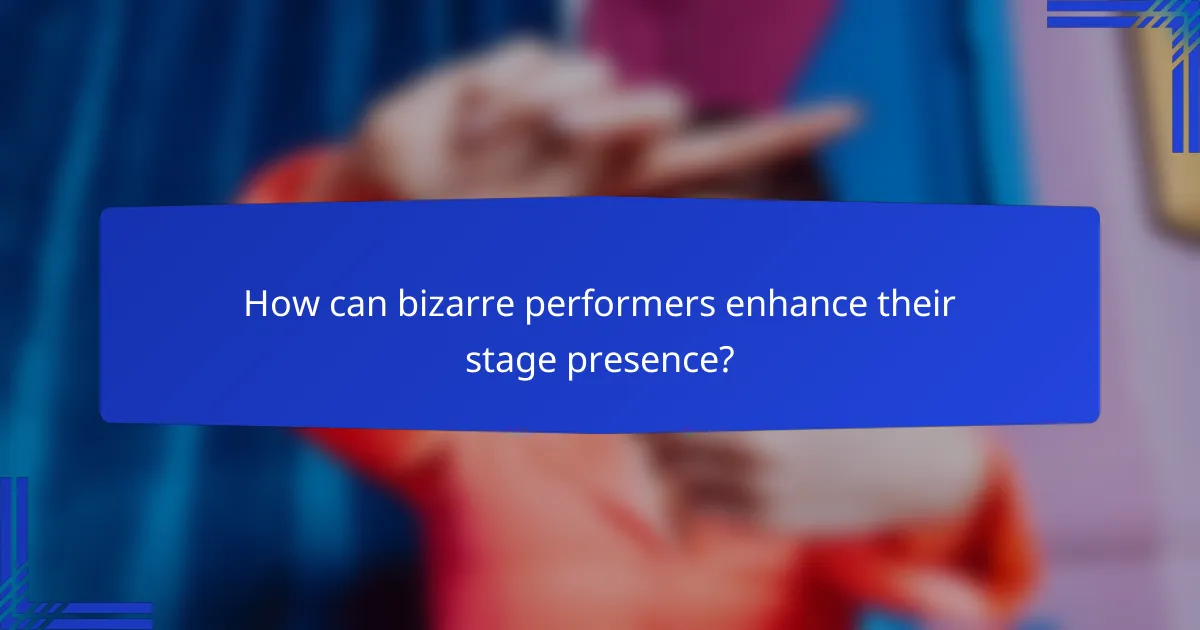Bizarre performers often navigate the complexities of performance anxiety while striving to meet audience expectations for novelty and engagement. Techniques such as mindfulness and peer support can help them manage stress and build resilience. As they confront their fears, these performers not only enhance their craft but also embark on a journey of personal growth and self-improvement.

How can performers overcome performance anxiety in Canada?
Performers in Canada can effectively manage performance anxiety through various techniques that promote mental clarity and confidence. Strategies such as mindfulness, breathing exercises, professional coaching, peer support, and gradual exposure therapy can help individuals build resilience and reduce stress during performances.
Mindfulness techniques
Mindfulness techniques involve focusing on the present moment and acknowledging feelings without judgment. Practices like meditation or mindful observation can help performers become more aware of their thoughts and emotions, reducing anxiety. Engaging in mindfulness for just a few minutes daily can lead to significant improvements in performance confidence.
Incorporating mindfulness into a pre-performance routine can help performers center themselves and enhance their focus. Simple practices, such as body scans or guided imagery, can be particularly effective in calming nerves before taking the stage.
Breathing exercises
Breathing exercises are a practical way to manage performance anxiety by regulating the body’s stress response. Techniques such as diaphragmatic breathing or the 4-7-8 method can help slow the heart rate and promote relaxation. Practicing these exercises regularly can make them more effective during high-pressure situations.
For instance, performers can take a deep breath for four counts, hold it for seven counts, and exhale for eight counts. This simple technique can be done discreetly before stepping on stage, helping to alleviate anxiety and improve focus.
Professional coaching
Working with a professional coach can provide tailored strategies for overcoming performance anxiety. Coaches can offer personalized feedback and techniques that address specific challenges faced by performers. They often use role-playing and visualization to help individuals prepare for various scenarios.
In Canada, many coaches specialize in performance anxiety and can help clients develop coping strategies. Investing in coaching sessions can lead to long-term benefits, enhancing both performance skills and emotional resilience.
Peer support groups
Joining peer support groups allows performers to share experiences and coping strategies in a safe environment. These groups can provide a sense of community and understanding, which is essential for managing performance anxiety. Engaging with others who face similar challenges can normalize feelings of anxiety and foster encouragement.
Many cities in Canada offer local support groups for performers, where individuals can meet regularly to discuss their experiences and practice techniques together. This shared journey can significantly reduce feelings of isolation and fear.
Gradual exposure therapy
Gradual exposure therapy involves slowly facing performance-related fears in a controlled manner. This technique helps desensitize individuals to anxiety-provoking situations by starting with less intimidating scenarios and gradually increasing the difficulty. For example, a performer might begin by practicing in front of a small group before advancing to larger audiences.
In Canada, therapists specializing in performance anxiety can guide individuals through this process, ensuring that exposure is manageable and supportive. This method can lead to increased confidence and a more positive association with performing over time.

What are audience expectations for bizarre performances?
Audience expectations for bizarre performances often revolve around novelty, engagement, and high energy. Spectators anticipate unique experiences that challenge norms, provoke thought, and entertain in unexpected ways.
Engagement and interaction
Engagement is crucial in bizarre performances, as audiences expect to be part of the experience rather than mere observers. Performers can enhance interaction through direct communication, inviting audience participation, or incorporating improvisation based on audience reactions.
For example, a performer might ask audience members to suggest ideas or themes, creating a collaborative atmosphere. This not only boosts engagement but also helps alleviate performance anxiety by fostering a sense of community.
Unique and unexpected content
Audiences seek content that is distinctive and surprising, often pushing boundaries of conventional performance art. This can include unusual themes, unexpected twists in storytelling, or unconventional use of props and costumes.
To meet these expectations, performers should focus on originality and creativity. Incorporating elements that challenge societal norms or explore taboo subjects can captivate audiences and leave a lasting impression.
High energy and enthusiasm
High energy and enthusiasm are vital components of a successful bizarre performance. Audiences expect performers to exhibit passion and dynamism, which can enhance the overall experience and maintain audience interest.
Performers should consider using varied pacing, dramatic gestures, and vocal modulation to convey excitement. Practicing techniques to manage performance anxiety can also help maintain high energy levels, ensuring that the performance resonates with the audience.

How does personal growth relate to performance anxiety?
Personal growth is closely linked to performance anxiety, as overcoming this anxiety often leads to increased confidence and self-improvement. By addressing the fears associated with performing, individuals can develop skills that not only enhance their performance but also contribute to their overall personal development.
Building resilience
Building resilience is essential for managing performance anxiety. It involves developing the ability to bounce back from setbacks and maintain a positive outlook despite challenges. Techniques such as setting realistic goals and embracing failure as a learning opportunity can help strengthen resilience.
For instance, performers can start by gradually exposing themselves to performance situations, beginning with smaller audiences before progressing to larger ones. This incremental approach helps build confidence and reduces anxiety over time.
Enhancing self-awareness
Enhancing self-awareness is a key aspect of personal growth that directly impacts performance anxiety. By understanding their triggers and emotional responses, individuals can better manage their anxiety during performances. Self-reflection practices, such as journaling or meditation, can aid in this process.
For example, performers might identify specific thoughts that increase their anxiety, such as fear of judgment. Recognizing these patterns allows them to challenge and reframe these thoughts, leading to a more positive mindset.
Developing coping strategies
Developing coping strategies is crucial for managing performance anxiety effectively. Techniques such as deep breathing, visualization, and positive self-talk can help performers calm their nerves and focus on their tasks. These strategies can be practiced regularly to build familiarity and effectiveness.
Additionally, creating a pre-performance routine can provide a sense of control and comfort. This routine might include warming up, reviewing key points, or engaging in relaxation exercises, helping to mitigate anxiety and enhance performance quality.

What frameworks can help in managing performance anxiety?
Several frameworks can effectively assist individuals in managing performance anxiety, including Cognitive Behavioral Therapy (CBT) and various performance preparation techniques. These methods focus on altering negative thought patterns and enhancing readiness, which can significantly reduce anxiety levels.
Cognitive Behavioral Therapy (CBT)
Cognitive Behavioral Therapy (CBT) is a structured, time-limited approach that helps individuals identify and challenge negative thoughts related to performance. By reframing these thoughts, individuals can develop healthier perspectives and reduce anxiety. CBT typically involves sessions with a trained therapist who guides the individual through exercises and strategies.
Key steps in CBT include recognizing anxious thoughts, evaluating their validity, and replacing them with more constructive beliefs. For example, instead of thinking “I will fail,” one might reframe it to “I have prepared well and can handle this.” Regular practice of these techniques can lead to lasting improvements in managing performance anxiety.
Performance preparation techniques
Performance preparation techniques are practical strategies aimed at enhancing readiness and confidence before a performance. These can include visualization exercises, where individuals imagine themselves succeeding in their performance, and rehearsal practices that simulate the actual performance environment. Such techniques help familiarize performers with the setting and reduce uncertainty.
Another effective method is developing a pre-performance routine, which can include warm-up exercises, breathing techniques, or positive affirmations. Establishing a consistent routine can signal to the mind and body that it is time to perform, thereby reducing anxiety. Avoiding last-minute changes to the routine is crucial, as this can increase stress and disrupt focus.

What role does feedback play in performer development?
Feedback is crucial for performer development as it provides insights into strengths and areas for improvement. Constructive input from various sources helps performers refine their skills and adapt to audience expectations.
Constructive criticism
Constructive criticism offers specific, actionable suggestions that help performers enhance their craft. It should focus on observable behaviors rather than personal attributes, ensuring that feedback is both helpful and respectful.
For example, a director might suggest adjusting a vocal delivery for better clarity rather than commenting on the performer’s overall talent. This type of feedback encourages growth by providing clear guidance on what can be improved.
Audience feedback mechanisms
Audience feedback mechanisms, such as surveys or live reactions, allow performers to gauge their impact and effectiveness. Engaging with the audience through Q&A sessions or social media can provide valuable insights into their preferences and expectations.
Performers can also observe audience reactions during performances, noting laughter, applause, or silence as indicators of engagement. This real-time feedback helps them adjust their performance style to better connect with viewers and enhance overall experience.

How can bizarre performers enhance their stage presence?
Bizarre performers can enhance their stage presence by embracing unique techniques that captivate audiences and build confidence. Key methods include improvisation training, which fosters spontaneity, and understanding audience expectations to create a more engaging experience.
Improvisation training
Improvisation training is essential for bizarre performers as it encourages quick thinking and adaptability on stage. By practicing improvisation, performers learn to respond to unexpected situations, which can significantly enhance their stage presence.
Engaging in regular improvisation exercises, such as games or workshops, helps build confidence and reduces performance anxiety. These activities can range from simple word association games to more complex scene-building exercises, allowing performers to explore their creativity in a supportive environment.
To get started, performers can join local improv groups or take online classes. It’s beneficial to focus on listening skills and collaboration, as these elements are crucial for successful improvisation and can lead to memorable performances.
